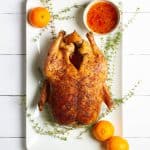Slow-Roasted Duck with Sweet + Sour Sauce
This slow-roasted duck is an easy, low-effort whole duck recipe. The bird is slow cooked for about 4 hours until tender, and served with an easy homemade sweet and sour sauce.
Servings: 4 people
Calories: 779kcal
Equipment
- roasting pan (with rack) OR cast iron skillet with meat trivet
- kitchen twine (or toothpick)
- digital thermometer (leave-in if possible)
Ingredients
Slow-Roasted Duck:
- 4½ - 5½ pound duck Neck + gizzards removed. Duck completely thawed. (See recipe note "What type of duck?")
- 1 tablespoon sea salt Or less, see recipe note "How much salt?"
- 2 teaspoons garam masala (optional) Or use Chinese 5-spice
- 1 orange, cut into 8 wedges Or ~3 mandarin oranges, halved
Sweet + Sour Sauce:
- 1 tablespoon rendered duck fat (from the pan) Or use toasted sesame oil
- ¼ cup rice vinegar
- 2 tablespoons mango chutney Or use orange marmalade
- 2 teaspoons fish sauce Or use soy sauce
- ½ teaspoon red chili flakes Omit if your mango chutney is spicy
- 1 garlic clove, minced
Instructions
Prepare the Duck:
- Optionally, place the duck breast-side up (spine-side down) in a glass casserole dish and set uncovered in the fridge for 8 to 24 hours. This will help dry out the duck skin so that it gets crispier while cooking.For the best results, pour off as much of the liquid from the raw bird as possible before placing in the glass dish.If your bird was wet-brined (many store-bought ducks are), this optional chill time is highly recommended to help dry out the skin.
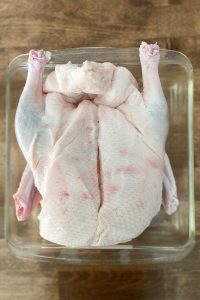
- Cut off the lower parts of the wings. (This section is almost all bone.)Check the neck and cavity, and trim away any loose fat (if present). Check the base of the tail and remove fat glands (if present) and any yellow residue. (Many ducks from the supermarket will already have the fat trimmed.)
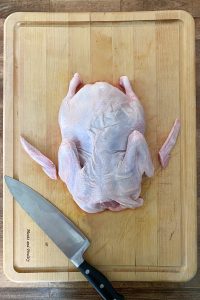
- Place the duck breast-side up (spine-side down) on the cutting board.Use a sharp paring knife, held at an angle, and prick the bird at half-inch intervals down the thighs, back and the lower part of the breasts. This step will help the fat drain from behind the skin while cooking.If your bird has exceptionally thick skin (or if your knife is a little dull), skip this step for now and prick the skin after the bird has been in the oven about 30 minutes.

Season the Duck:
- Season the duck liberally with the sea salt. Sprinkle it over the outside of the bird and in the cavity. (If your bird was wet-brined in water and salt, it will need less salt than indicated. Refer to the recipe notes.)If using, rub the garam masala evenly over the outside of the bird.
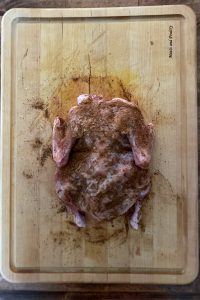
- Add the oranges to the cavity.(If it seems like the oranges won't fit, your bird is backwards. Flip the duck around and try the cavity on the other side next to the legs.)
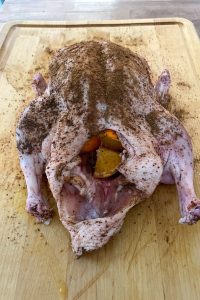
- Use kitchen twine to tie the duck legs together (to keep the cavity closed), or secure the cavity with a toothpick.(You do not need to perfectly truss the bird, you just want to secure the oranges and prevent hot air from cooking the inside of the duck.)

Cook the Duck:
- Place an oven rack in the center of the oven. Preheat oven to 250° Fahrenheit. (Both standard oven and convection oven directions follow.)Place the duck breast-side up (spine-side down) on a roasting pan with a rack, or set in a cast-iron pan with a meat trivet added. (The rack or trivet will raise the bird up so that it's not resting in duck fat while cooking.)Put the duck in the oven and roast 4 to 6 hours (standard oven) or 2½ to 3½ hours (convection oven), depending on the size of the bird. If you've got a leave-in thermometer, add it now.If using a standard oven, pull the bird out of the oven and prick the skin again to help release the fat once per hour. For a convection oven, prick the skin every 30 minutes. As the bird cooks, pay attention to areas where the fat is staying thick (and not releasing), and make sure to poke holes in those areas.
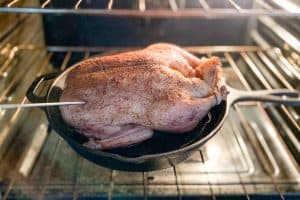
- When the duck skin is thin and most of the fat has rendered, or when the bird has reached approximately 145° Fahrenheit (medium-doneness), increase the heat to 500° Fahrenheit and cook about 15 more minutes to crisp up the skin.Optionally, check to see if the duck has reached an internal temperature between 155° Fahrenheit (medium well) to 165° Fahrenheit (well done). See recipe notes.
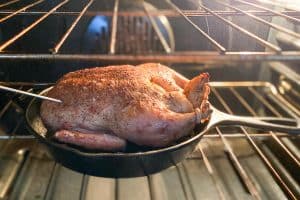
Finish the Duck + Make the Sauce:
- Carefully transfer the bird from the roasting pan to a carving board, and let rest uncovered for at least 15 minutes. (A 30-minute rest is preferable if you've got time.)Pour the rendered duck fat from the roasting pan into a glass jar. Measure out 1 tablespoon of the fat for the sauce. Let the remaining fat cool, and then store in the fridge for another use.

- While the duck rests, add all the sweet and sour sauce ingredients to a saucepan. Stir and bring to a simmer. Continue simmering for about 2 minutes, or until the sauce begins to thicken, and then remove from heat.

- Cut open the trussing twine (or remove the toothpick) and carefully remove the orange segments using a fork or tongs. The oranges will be hot! Discard the oranges, or, optionally, squeeze their juice into the sauce.Carve the duck or gently tear it apart. Move the duck to a serving platter. Serve immediately along with the sauce.Store leftovers in the fridge for up to 2 days, or wrap tightly and freeze for up to a month. To reheat, place on a baking sheet and place in a 475° Fahrenheit oven for 10-15 minutes, until warm.
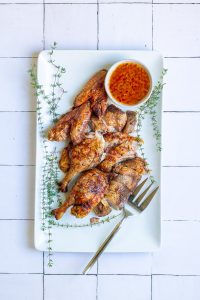
Notes
Serves 4 if you also have several side dishes, or 2 with just one or two sides. (Ducks have less meat than a similarly sized chicken.)
Cook Time lists the minimum cook time in a standard oven, and does not include the optional 8 to 24 hour chill time in the fridge. Actual times will vary depending on the size of your bird, your oven and whether or not you use a convection oven setting.
Standard oven or convection oven?
- A standard oven will take a lot longer to cook the duck, and the texture of the meat will be exceptionally soft. You'll likely be able to tear the meat instead of cutting if desired.
- A convection oven will cook the bird more quickly, will help make the skin as crispy as possible, and the meat will still be tender and juicy. You'll likely need to cut the meat, as it will be slightly less "fall-off-the-bone" tender.
- Either option works well. A convection oven is my personal preference.
- This recipe was tested using Pekin duck. (Most ducks available in American grocery stores are Pekin duck.)
- If using wild duck (game meat), your bird will likely be much smaller and will cook more quickly. I highly recommend using a leave-in digital thermometer (with an alarm, if possible) to avoid over-cooking.
- If using table salt, use half the salt (1 and ½ teaspoons salt)
- Many store-bought ducks are already wet-brined with salt. (The label may read "seasoned with water and sea salt.") If your duck is brined, use half the amount of salt called for (1 and ½ teaspoons sea salt)
- Look for an air-dried duck. (These can be hard to find.)
- If your duck was brined before purchase, it may be harder (but not impossible) to get the skin extra crispy.
- Chill your thawed duck uncovered in the fridge for 8 to 24 hours before cooking. This will help dry the skin. (Dry skin = crispier skin.)
- If possible, use a convection oven setting to cook the bird.
Nutrition
Calories: 779kcal | Carbohydrates: 12g | Protein: 113g | Fat: 28g | Saturated Fat: 8g | Polyunsaturated Fat: 4g | Monounsaturated Fat: 8g | Cholesterol: 440mg | Sodium: 2311mg | Potassium: 1604mg | Fiber: 2g | Sugar: 8g | Vitamin A: 449IU | Vitamin C: 54mg | Calcium: 38mg | Iron: 26mg
